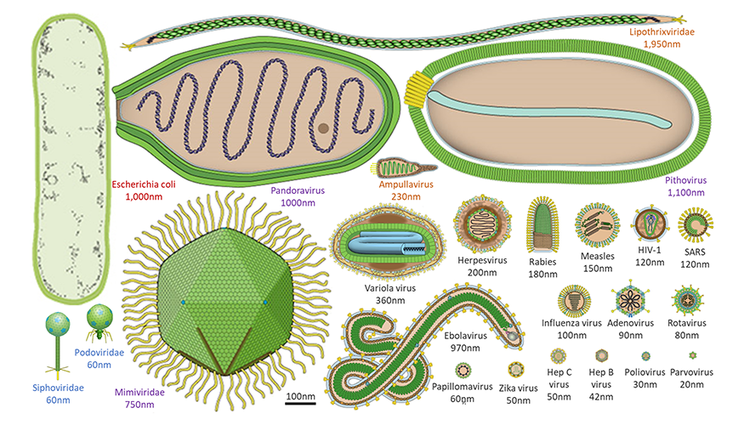Researchers explore how viruses enhance our understanding of life in the universe
 (Download Image)
(Download Image)
Example viruses illustrate the diversity of viral structure and size, ranging from a few to thousands of nanometers. Here, an example bacterium, Escherichia coli (top left, red text), is contrasted with the example viruses.
On Earth, viruses are abundant and an integral part of life. However, very little is known about them outside human health contexts, especially in areas related to space. Understanding the role viruses play on Earth and how they interact with their hosts in extreme environments can better inform human spaceflight missions (environmental control, life support systems, and microbiomes) and the search for life elsewhere. To this end, Lawrence Livermore researchers and collaborators reviewed previous research in this area and identified specific knowledge and technical gaps that should be addressed in future research.
The diversity and quantity of viruses on Earth, as well as their effect on cellular life, their role in evolutional history, and their physical interactions with the Earth system, provide fundamental information that could be applied to the search for life on other worlds. More research into the roles of viruses in the origin of life on Earth—and their continued role in evolution—may highlight opportunities for detecting emergent life on other worlds. Additionally, further exploration into the habitability, persistence, and process limits of viruses and cellular life, and the ways viruses affect biogeochemical cycling, may help illuminate biosignatures on distant planets, or signatures of past life in the geologic records of other worlds.
As human spaceflight expands, an area of increasing interest is how viruses interact with other viruses and their hosts in space environments. Previous spaceflight studies excluded viruses, so little is known about the effect of viruses on crew health and instrument and shuttle performance. Understanding how viruses are impacted and shaped by their environment could inform nearly every aspect of a mission. Additionally, studying the environment of existing space stations and crewmember microbiomes would provide information about how viruses spread and encounter hosts in a microgravity environment.
Although researchers can use a variety of existing instrumentation and techniques to detect and study viruses on Earth, it is unclear how these will perform beyond Earth. To fully understand the presence of viruses in space environments, new technologies and methodologies need to be developed and incorporated into standard operating procedures for future missions.
The Laboratory Directed Research and Development program supported this work (21-LW-060).
[G. Trubl, K.M. Stedman, K.F. Bywaters, E.E. Matula, P. Sommers, S. Roux, N. Merino, J. Yin, J.T. Kaelber, A. Avila-Herrera, P.A. Johnson, J.C. Johnson, S. Borges, P.K. Weber, J. Pett-Ridge, and P.J. Boston, Astrovirology: how viruses enhance our understanding of life in the Universe, International Journal of Astrobiology (2023), doi: 10.1017/S1473550423000058.]
–Physical and Life Sciences Communications Team
Tags
Bioscience and BioengineeringBiosciences and Biotechnology
Nuclear, Chem, and Isotopic S&T
Nuclear and Chemical Sciences
Physical and Life Sciences
Featured Articles







